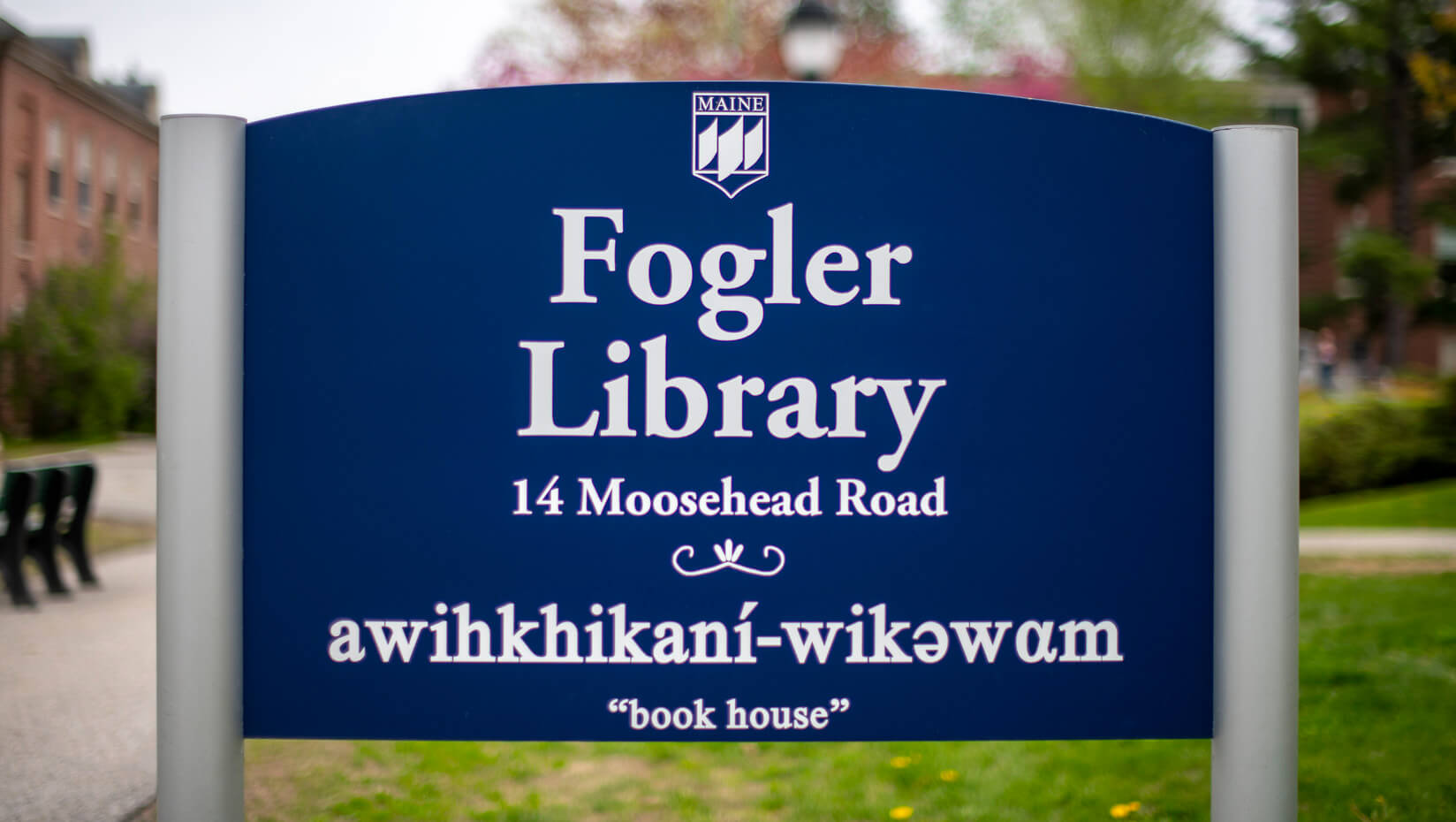
Bilingual signage — English and Penobscot — now at UMaine
New University of Maine building and road signage on campus is now bilingual — English and Penobscot.
Signs for Memorial Gym and New Balance Student Recreation Center note the names in Penobscot — αttali-milahəyαwələtimək — translated as “place where you play a variety of games.” At Fogler Library, awihkhikaní-wikəwαm means “book house”; at Wells Conference Center, mαwikamikʷ translates as “community meeting house”; and at Cutler Health Center, sαkəlamálsəwαkan mαwte translates as “get your health together.”
The signs for Long Road include a more literal kʷənawətik, “on the long road,” and Rangeley Road signs include a more evocative àkʷəssok, “at the blueback trout place” — reflecting the Penobscot place-name for Rangeley, Maine.
The project, now in its first phase with the installation of 10 signs across campus and internal signage throughout the halls of UMaine’s Wabanaki Center, developed from conversations between the UMaine Wabanaki Center and Wabanaki communities in Maine over the last few years regarding the relative invisibility of Indigenous people, places, history and languages at the university, and the specific need for Penobscot language signage on the Orono campus.
“One of the goals of the signs is to show students and visitors that the university’s campus is on Wabanaki territory,” says Darren Ranco, director of Native American Programs at UMaine. “Hopefully the signage will orient our students to a more meaningful relationship with where they are in the world.”
A Penobscot Language Signage Committee met regularly in the spring 2018 semester, chaired by Ranco and including alumni Carol Dana, Penobscot language master with Penobscot Cultural and Historic Preservation; James Eric Francis Sr., director of Penobscot Cultural and Historic Preservation, and tribal historian for the Penobscot Nation; Gabriel Paul, language instructor with Penobscot Cultural and Historic Preservation. Other committee members were Margaret Pearce, faculty associate with the UMaine Canadian-American Center; and UMaine students and Penobscot Nation members Claudia Cummings and Shantel Neptune.
The committee worked extensively on the Penobscot translations, writing historical content for the signage and reviewing Indigenous signage used at other universities. The project plan and translations were also reported to and reviewed by the Penobscot Nation Tribal Council.
“I think this project is progressive for Indigenous communities and the Indigenous students who attend the University of Maine,” says Cummings, a social work major. “The signs will make native students feel recognized and welcomed.”
The committee envisioned the signage as an opportunity to make the unseen places, people, languages and historical narratives of indigeneous communities visible and meaningful, as well as creating a more inclusive and respectful space for native students on campus.
The first bilingual sign was installed in the fall 2018 in front of Corbett Hall, which houses the Wabanaki Center. The word wαpánahkik is printed on the sign with the translation “in the dawnland.” Dawnland is the Wabanaki name for their homeland, and the sign reminds passersby that the Orono campus is situated on Marsh Island, within the Wabanaki and Penobscot homeland.
“It’s about claiming space,” says Ranco. “It’s also about reclaiming words.”
Five categories of Penobscot language signage have been planned, including: signs that restore and correct Penobscot words, spellings and meanings on existing campus signage; signs that place Penobscot words and meanings in places of authority; signs that provide perspective on Penobscot history and the Penobscot landscape; signs that empower Native American Programs to self-identify in the host language; and signs that translate the meanings of English concepts on existing campus signage.
“The signs will help our community to acknowledge the past, learn from it, and be better for it,” says Robert Dana, UMaine vice president for student life and dean of students. The President’s Office and the Division of Student Life funded the first phase of the signage project.
Many of the external signs in phase one of the project were designed to create an awareness of place while also evoking the traditional activities of the spot where they stand and the presence of multiple, living languages for places.
“There’s not a word for museum in the Penobscot language, so a translation of museum would be more about evoking the concept of memory,” says Ranco. “These signs will hopefully encourage us to reconsider the way we interact with these spaces and to feel connected to them in the way Penobscot people do.”
Ranco also recognizes the playfulness of the Penobscot language and that the signage should capture the imagination of passersby. For instance, the Penobscot greeting now displayed on the football field’s digital sign, kkʷey pahkʷinάkʷəsəyekʷ, translates as “hello, you all are pleasing to the eyes.”
The second phase of signs have been designed and will be installed along UMaine’s Mall. Phase three of the project will include larger entrance signs in prominent places across campus.
To spread awareness of the signs on campus, a celebration event is being planned. The Wabanaki Center also hopes to have a website and pronunciation guide ready for when students return in the fall.
Ranco believes that the success of the project and the positive feedback reflect deepening collaborations between the university and Indigenous communities, and the commitment of everyone involved.
Cummings is looking forward to seeing more signs across the UMaine Orono campus.
“I will see these signs everyday and be reminded of our people and culture.”
Contact: Margaret Nagle, 207.581.3745
